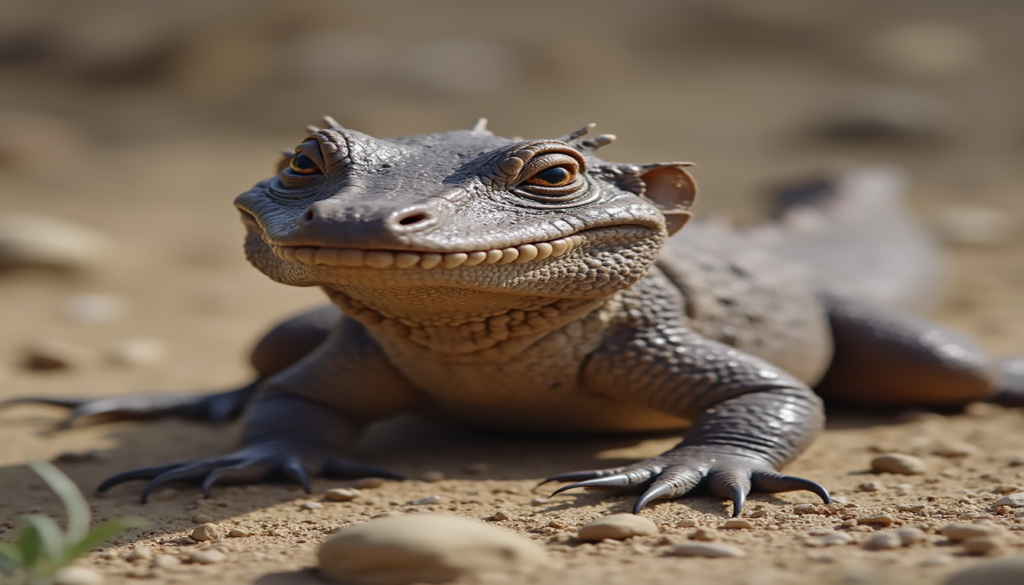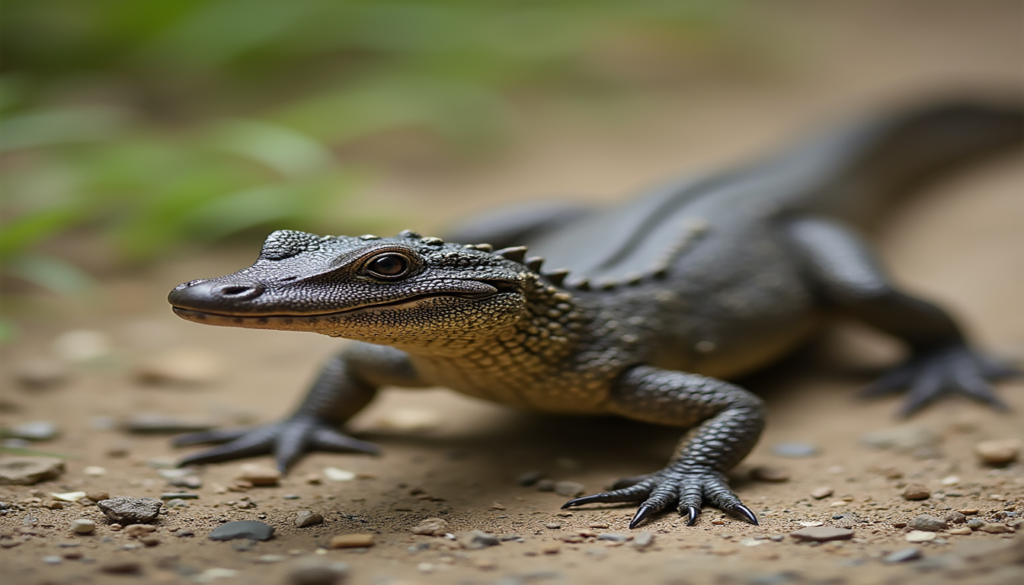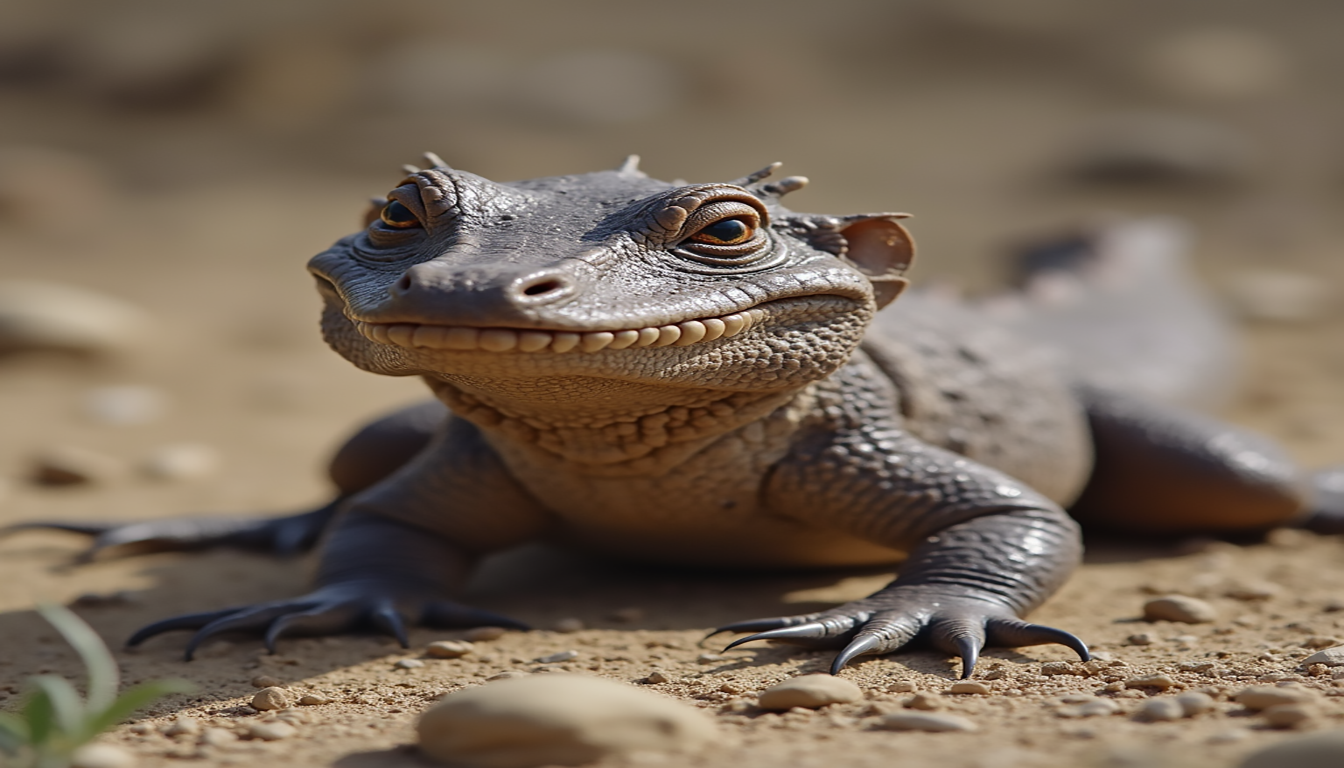
Imagine a creature from a science fiction novel that swam on Earth millions of years ago. The Diplocaulus, a prehistoric amphibian, has a boomerang-shaped head. It lived from the Late Carboniferous to Early Permian periods, about 305 to 255 million years ago.
This ancient creature was found mainly in North America. Its boomerang head was not just for looks. It was a clever way to survive in the water.
Paleontologists are fascinated by the Diplocaulus. They study its unique features. The boomerang head helped it move and hunt in its ancient home.
Table of Contents
Introduction to the Prehistoric Wonder
Explore the world of Diplocaulus, a prehistoric amphibian that amazed scientists. This creature is key to understanding ancient life. It gives us a peek into how early amphibians evolved.
Origins and Classification
The Diplocaulus lived during the Permian period. It’s part of the Nectridea order, a unique group of early tetrapods. These creatures showed amazing adaptations.
- Taxonomic group: Amphibia
- Order: Nectridea
- Geological period: Permian (299-251 million years ago)
Timeline of Discovery
Fossils of Diplocaulus were found on different continents. This made it clear how important they are:
| Location | Year of First Discovery | Significance |
|---|---|---|
| Texas, USA | 1878 | First detailed fossil description |
| Oklahoma, USA | 1885 | Additional skeletal evidence |
| Morocco | 1900 | International fossil distribution confirmation |
Significance in Paleontology
Every Diplocaulus fossil is a big find for science. They help us see how early amphibians adapted to their world. They also show how these creatures survived in different environments.
“The Diplocaulus provides an extraordinary window into the evolutionary innovations of early amphibian life.” – Dr. Emily Rodriguez, Paleontological Research Institute
The discovery of Diplocaulus still excites scientists today. It lets us look into the ancient world of ecosystems.
The Distinctive Boomerang-Shaped Head Structure
The Diplocaulus skull is a standout in prehistoric amphibian anatomy. Its boomerang-shaped head is a remarkable adaptation that has long intrigued scientists. It’s like nature crafted a natural weapon for this ancient creature.
The boomerang head of Diplocaulus had several key roles in its underwater world. Experts think it helped the creature move better in water, scare off predators, and even hunt more effectively.
- Enhanced hydrodynamic movement through water
- Potential intimidation of potential predators
- Improved sensory capabilities
- Specialized hunting techniques
Fossils show that the Diplocaulus skull might have been connected by flexible skin. This made the creature look bigger and scarier. The long squamosal bones formed “horns” that made its silhouette unique.
*The boomerang head was not just a bizarre feature, but a sophisticated evolutionary strategy.*
Scientists have found many Diplocaulus species, each with different skull shapes. These discoveries help us understand the variety of early amphibians and how they adapted to their environments.
The unique design of the Diplocaulus skull still captivates researchers. It gives us a glimpse into the evolution and survival strategies of prehistoric amphibians.
Physical Characteristics and Size
The Diplocaulus is a standout in the world of prehistoric amphibians. Its unique features give us a peek into the evolution of aquatic life during the Permian period.
Body Length and Distinctive Size
The Diplocaulus was a large prehistoric amphibian, measuring 2-3 feet long. It weighed about 10-20 pounds. This made it much bigger than today’s amphibians.
Skeletal Features
The Diplocaulus had a boomerang-shaped head, unlike any other ancient creature. Its skeleton showed it was built for powerful swimming. It was perfectly adapted to life in the water.
- Unique boomerang-shaped skull
- Robust limb structures
- Streamlined body design
- Powerful tail for swimming
Skin and External Appearance
Fossils tell us the Diplocaulus had a cool look. Its skin was dark brown or black with lighter spots. This helped it blend in with ancient water environments.
| Characteristic | Details |
|---|---|
| Length | 2-3 feet (60-90 cm) |
| Weight | 10-20 pounds (4.5-9 kg) |
| Swimming Speed | 7 mph (11 km/h) |
| Typical Coloration | Dark brown/black with lighter spots |
“The Diplocaulus represents a fascinating chapter in the evolutionary story of amphibian life.” – Paleontological Research Journal
Habitat and Geographic Distribution
The Diplocaulus lived in a special environment during the Late Carboniferous to Early Permian periods. These creatures were experts in ancient freshwater habitats. They thrived in areas with the right moisture to survive.
Their habitat was mainly in North America. Fossils were found in:
- Texas
- Oklahoma
- New Mexico
They needed constant moisture to keep their skin wet. Like modern amphibians, they stayed near water all the time.
“The Diplocaulus was perfectly adapted to its aquatic world, a true testament to nature’s remarkable evolutionary designs.”
Scientists have learned a lot about their range from fossils. Here’s where they were found:
| Region | Fossil Abundance | Habitat Type |
|---|---|---|
| North America | High | Freshwater marshes |
| Morocco | Moderate | Ancient river systems |
Learning about the Diplocaulus habitat helps us understand ancient ecosystems. Their unique adaptations allowed them to live in challenging environments.
Diplocaulus Hunting Techniques
Explore the world of the Diplocaulus, a prehistoric amphibian predator. It hunted underwater millions of years ago. This creature had unique hunting techniques that made it stand out.
The Diplocaulus was a master of underwater ambush hunting. Its boomerang-shaped head was not just for looks. It was a key adaptation that made it a top predator.
Ambush Predator Strategy
Picture a prehistoric hunter hiding on the river bottom, waiting to attack. The Diplocaulus used a special technique with its unique head:
- Positioned itself facing against the current
- Used its distinctive head to provide hydrodynamic lift
- Waited motionless on the riverbed
- Launched sudden, explosive attacks on unsuspecting prey
Prey Selection
This prehistoric amphibian predator hunted small aquatic creatures with great precision. It focused on:
- Small fish swimming above
- Aquatic arthropods
- Tiny marine organisms
Hunting Environment
Diplocaulus hunting took place in freshwater marshes and swamps. Its head shape allowed it to move through fast rivers and streams. It was a top predator in its ancient world.
“Nature’s perfect underwater ambush hunter” – Prehistoric Amphibian Research Journal
Evolutionary Adaptations for Aquatic Life

Diplocaulus is a key part of prehistoric amphibian history. These ancient creatures had special traits that helped them live in water during the Late Carboniferous to Early Permian periods.
The journey of Diplocaulus shows how they adapted to survive:
- Streamlined body shape for efficient swimming
- Specialized boomerang-shaped head for navigating water currents
- Powerful tail providing sudden burst of speed during hunting
Learning about Diplocaulus’ adaptations helps us see how they became top predators. Their unique features made them expert hunters in the water.
The boomerang-shaped skull wasn’t just a quirk of nature, but a sophisticated evolutionary strategy for survival.
Diplocaulus had key traits that set them apart in ancient waters:
| Adaptation | Functional Purpose |
|---|---|
| Elongated Tail | Enhanced swimming speed and maneuverability |
| Unique Head Shape | Improved water current navigation |
| Streamlined Body | Reduced water resistance while hunting |
These special features made Diplocaulus a top predator in ancient waters. They show the amazing ability of early amphibians to adapt.
Diet and Feeding Behavior
The Diplocaulus was a fascinating prehistoric amphibian with a unique approach to hunting and feeding. It developed remarkable strategies for survival in its prehistoric environment.
Primary Food Sources
The Diplocaulus diet mainly included small aquatic creatures. Its menu typically included:
- Small fish
- Aquatic invertebrates
- Tiny crustaceans
- Soft-bodied marine organisms
Feeding Mechanics
Prehistoric amphibian feeding techniques for the Diplocaulus were incredibly specialized. Its distinctive boomerang-shaped head played a crucial role in capturing prey with remarkable efficiency.
“The unique head shape was not just a remarkable feature, but a sophisticated hunting tool.”
Dietary Adaptations
The ancient aquatic predator diet of Diplocaulus showcased impressive evolutionary adaptations. Its powerful jaws and strategically positioned eyes allowed for precise hunting in shallow water environments.
| Hunting Characteristic | Description |
|---|---|
| Primary Habitat | Swamps and Shallow Waters |
| Hunting Speed | 15 mph (24 km/h) |
| Typical Prey Size | Small fish under 6 inches |
Its specialized feeding mechanism allowed the Diplocaulus to thrive in its prehistoric ecosystem. This shows the remarkable adaptability of early amphibian species.
Life Cycle and Reproduction
Looking into how Diplocaulus reproduced gives us a peek into ancient amphibian life. Scientists have made some guesses about how these creatures spread their kind during the Permian period.
Diplocaulus likely bred like modern amphibians. They probably laid eggs in shallow water. Their unique head shape might have helped in mating or showing territory.
“Unraveling the reproductive mysteries of extinct species requires careful scientific detective work and comparative analysis with modern amphibian relatives.”
- Probable water-based egg-laying strategy
- Potential complex mating rituals
- Aquatic environment critical for reproduction
- Limited fossil evidence challenges complete understanding
Paleontologists think Diplocaulus bred like today’s amphibians. Females might have laid hundreds of eggs in water. These eggs were likely eaten by predators, with only a few making it to adulthood.
| Reproductive Characteristic | Estimated Diplocaulus Trait |
|---|---|
| Egg Laying Environment | Shallow aquatic habitats |
| Estimated Egg Quantity | Potentially 100-500 eggs |
| Larval Development | Gradual metamorphosis |
Though we don’t know much, studying Diplocaulus reproduction is still exciting. It helps us learn about the evolution of ancient amphibians.
Survival Mechanisms and Defense
Surviving in ancient times was tough for Diplocaulus, a prehistoric amphibian. It had to find ways to stay safe in dangerous places. Its boomerang-shaped head was key to its survival.

Predator Avoidance Strategies
Diplocaulus used clever ways to avoid predators. Its head shape helped in many ways:
- It made it harder for predators to attack from the side.
- It helped it move smoothly through water.
- It might have confused predators, making it harder for them to catch it.
Environmental Challenges
Diplocaulus faced big challenges, especially when it moved between water and land. It was slow on land and had to watch out for big predators like Dimetrodon.
Protective Features
Diplocaulus had special features to protect itself:
- Its head was armored to absorb impacts.
- It could hide in aquatic plants.
- It could move quickly in water.
*”Survival in prehistoric ecosystems demanded extraordinary adaptations”*
Learning about how Diplocaulus avoided predators gives us a glimpse into the amazing ways early amphibians evolved.
Fossil Records and Discoveries
Diplocaulus fossils give us a peek into the lives of ancient amphibians. These fossils are key to understanding their past. First found in 1877, they show us what life was like underwater long ago.
- North American locations in Texas and Oklahoma
- Moroccan fossil sites in northwest Africa
Scientists have found many Diplocaulus species. Each one is unique:
| Species | Notable Features | Fossil Location |
|---|---|---|
| D. salamandroides | Smaller skull structure | Oklahoma |
| D. magnicornis | Prominent head protrusions | Texas |
| D. copei | Elongated cranial features | Morocco |
The fossils of Diplocaulus tell us a lot about their evolution. They show us their skulls, vertebrae, and sometimes even whole skeletons. This helps us understand how they lived.
Each fossil tells a story of survival in prehistoric aquatic environments, providing a window into a world long disappeared.
Learning about Diplocaulus fossils helps us see how life has changed over time. These ancient creatures continue to fascinate scientists. They promise to reveal more secrets about our planet’s past.
Impact on Modern Understanding of Ancient Life
Diplocaulus research has changed how we see ancient life and how amphibians evolved. By studying this unique creature, scientists have learned a lot about ancient life forms.
The study of Diplocaulus is more than its boomerang-shaped head. It has greatly improved our understanding of ancient life and evolution.
Scientific Contributions
Studying Diplocaulus has made our knowledge of ancient amphibians much deeper. Researchers have found important information about:
- How ancient creatures adapted
- How they interacted with their environments
- The early development of amphibians
Research Impact
The extraordinary fossil records of Diplocaulus have given us a unique look into ancient life. Scientists have used these finds to learn about ancient environments and how creatures survived.
| Research Focus | Key Discoveries |
|---|---|
| Morphological Adaptation | Unique boomerang-shaped skull design |
| Ecological Interactions | Predator-prey relationship insights |
| Evolutionary Mechanisms | Survival strategy developments |
Educational Significance
Museums and schools use Diplocaulus to teach about evolution. These studies show the amazing changes in life’s journey.
“Understanding extinct species like Diplocaulus helps us appreciate the remarkable complexity of life’s evolutionary path.” – Dr. Emily Roberts, Paleontologist
Conclusion
The Diplocaulus legacy shows us how important ancient amphibians were. This creature lived over 250 million years ago. It helps us see how life changed over time.
Its boomerang-shaped head and special features teach us about ancient worlds. Scientists learn a lot from studying it. They understand how life evolved through the ages.
Diplocaulus teaches us about life’s strength. Found in North America and Morocco, they show how life adapts. Their ways of moving and hunting teach us about survival and evolution.
Researchers keep finding new things about Diplocaulus. They learn about different types, like D. salamandroides and D. magnicornis. This helps us see the complexity of life long ago.
By studying Diplocaulus, we appreciate the intricate history of life. It shows us how every creature is important. It makes us think about the complexity of life and the need to keep exploring.
FAQ
What makes Diplocaulus so unique among prehistoric amphibians?
Diplocaulus is famous for its boomerang-shaped head. This sets it apart from other ancient amphibians. Its skull, with long squamosal bones forming horns, made it a standout creature.
When did Diplocaulus exist, and where was it found?
Diplocaulus lived from the Late Carboniferous to Early Permian periods, about 300-280 million years ago. Its fossils were mainly found in North America and Morocco. This shows it lived in ancient freshwater marshes and swamps.
How large was Diplocaulus compared to other prehistoric amphibians?
Diplocaulus was relatively small, usually between 30 to 60 centimeters long. Its compact body made it a swift predator in the water.
What type of predator was Diplocaulus?
Diplocaulus was an ambush predator that hunted in the water. It used its unique head and eyes to catch small fish and invertebrates quickly.
How did Diplocaulus’s head shape benefit its survival?
Its boomerang-shaped head helped it swim efficiently and possibly intimidate predators. It also played a role in mating displays. The head shape allowed for powerful hunting movements.
What challenges did Diplocaulus face in its prehistoric environment?
Diplocaulus faced seasonal changes, competition, and predators. Its streamlined body and special head helped it survive in the competitive aquatic ecosystems of its time.
How do scientists study Diplocaulus given its extinct status?
Scientists study Diplocaulus through fossil evidence like skull fragments and skeletons. They compare these with modern amphibians to understand its behavior and evolution.
What makes Diplocaulus important in the study of prehistoric life?
Diplocaulus offers insights into amphibian evolution and ancient aquatic ecosystems. Its unique features help scientists understand how life adapted and survived in the Paleozoic era.

